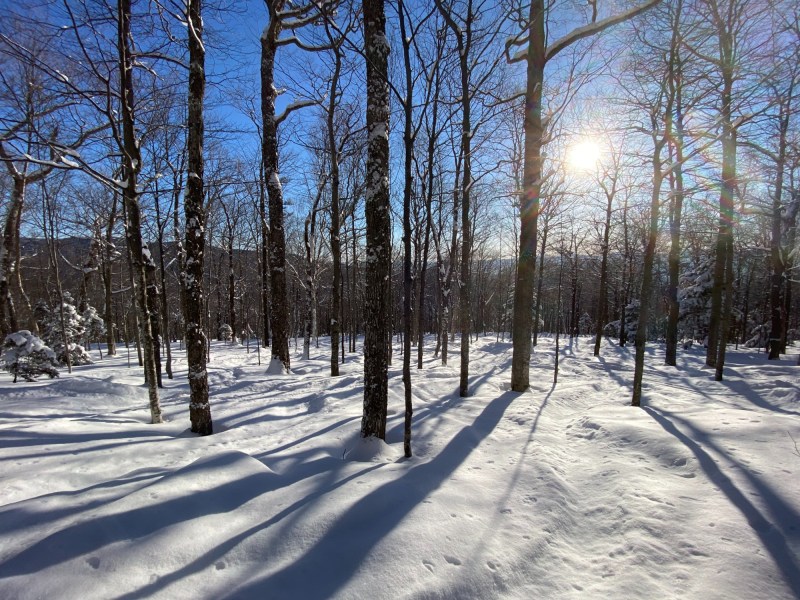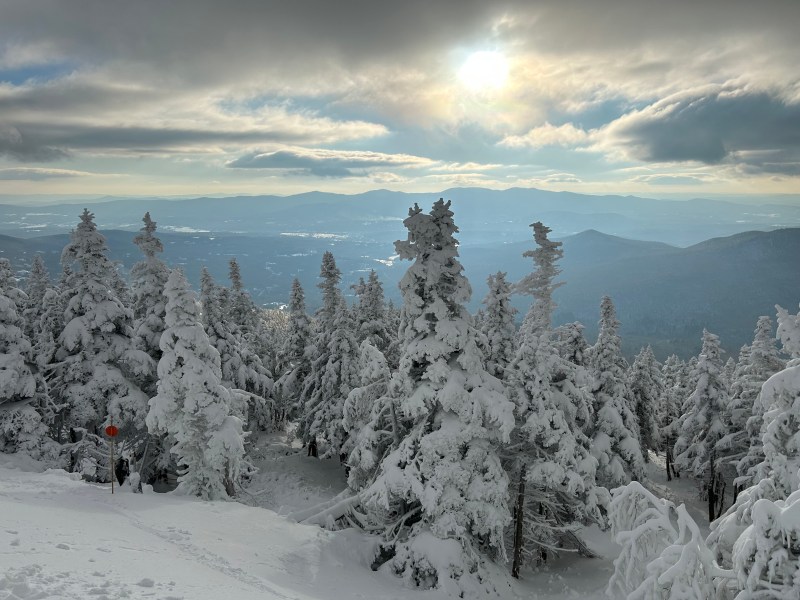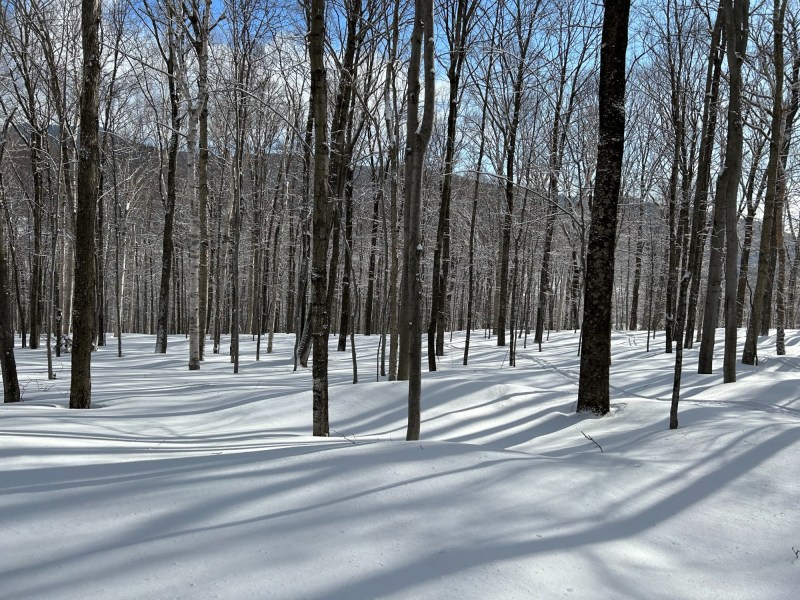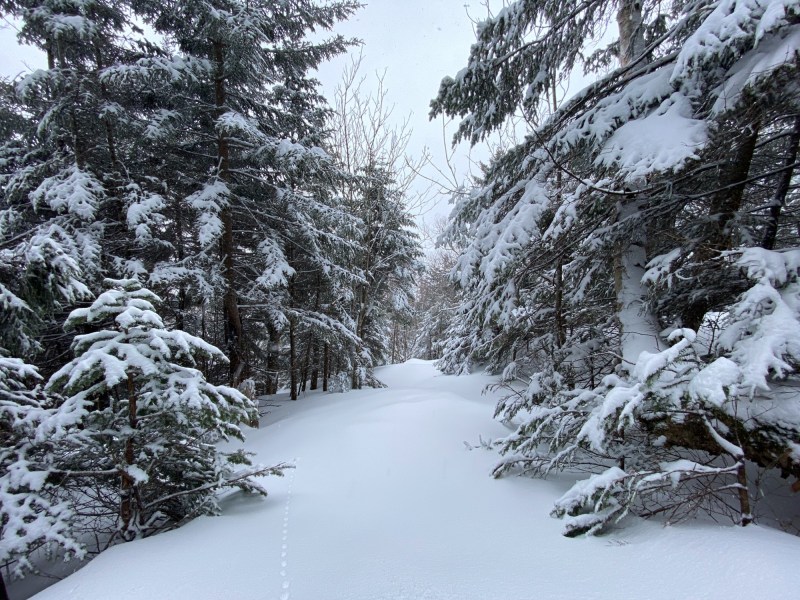
When I moved to Vermont in October 2021, I couldn’t wait to snowboard at Stowe Mountain Resort. Set amongst the state’s highest peak, Mt. Mansfield, the storied resort offered abundant freeride terrain and a unique local culture.
The “Front Four” double black diamond trails — Liftline, Starr, Goat, and National — provided challenging moguls and steeps. Long, winding groomers, like Lord and Sunrise, were ideal for early morning carves. And Mt. Mansfield’s highest point, “The Chin,” offered epic sidecounty lines.
But I didn’t give much consideration to tree runs, also referred to as glades. Sure, I’d heard about how fun powder days through the forest were. And I’d even done some tree riding myself out west. But as I rode with more and more locals, I began to understand that powdery tree runs were the highlight of the mountain. Not only that, but they taught me to be a better snowboarder.
Let’s explore the tree runs of Stowe Mountain Resort, what they taught me, and how they enhance the snowboarding experience.

Exploring the forest on a snowboard: what it taught me
I’m a lifelong snowboarder. I’ve ridden diverse terrain, from open bowls to gentle cruisers and everything in between. But when I first rode Stowe’s dense glades, I felt like a fish out of water. The tight confines demanded movements and lines I hadn’t yet learned. But over time, I adjusted and taught myself to work with the terrain. And in the process, I improved my overall snowboarding skills. Here’s how.
Stowe’s tree runs force you to ride your best. Like surfing a wave, your surroundings constantly change, and you have to react in an instant. Besides that, you have to concentrate on specific techniques and movements to maximize flow and fun.
Your snowboarding stance in the glades
As a snowboard instructor, I teach students to ride in a balanced, athletic stance. Picture a basketball player defending the perimeter. There’s ample flex in their hips, knees, and ankles, lowering their center of gravity and giving them the most opportunity for movement. In short, they’re ready for anything.
Not only does that enhance snowboarding performance, but it’s essential when riding glades. Riding through the forest is like negotiating an obstacle course. Wherever you look, there’s something to dodge, aim for, or jump over. Maintaining that flexed, neutral stance keeps you ready to react as the run unfolds.
Navigating trees on a snowboard
In contrast to wide, long turns on groomers, short, quick pivots are vital to tree riding. See a powder stash in the distance? You’ll have to whip your board around, change direction, and avoid obstacles on your way there. And that happens constantly and quickly.
To pivot my board fast, I blend two techniques: hip rotation and flexion/extension of my rear leg joints. When I’m ready to turn, I forcefully rotate my hips, transferring the energy through my legs to the board. As the tail swings back and forth, I flex and extend my rear knee/ankle/hip, pivoting the board around my front foot. In tight spots, it’s essential.
When to ride the glades
Lastly, the best tree runs are on powder days. While powder-specific boards enhance float in deep snow, you can also do that on your own.
I like to subtly lighten pressure on the nose and increase pressure on the tail, helping the board plane above the snow. To do that, as the board starts moving, I slightly flex my rear hip/knee/ankle and extend my front leg joints while sliding my hips toward the tail. It’s all about small, gradual movements. Picture a surfer in a long barrel, continually adjusting their balance and position.

How tree runs improve the snowboarding experience
As much as I enjoy snowboarding, taking lap after lap can be repetitive. But tree runs add a new dimension to the experience, offering exploration, creativity, and fun. And that’s especially true on a sunny powder morning.
On powder days at Stowe, runs get tracked out pretty quickly. After about an hour, most open powder fields are gone. But not in the glades.
After a big snow, as I exit the chairlift, I head right for the forest. Usually, there’s barely anyone there. I float and weave through deep stashes and rolling undulations while the trees form shadows against the morning sunlight. It’s like having my own private skatepark.
When I’m done, hitting a groomer is refreshing and relaxing, letting me make long, graceful turns and stretch my legs. Going back and forth between the two makes a day on the mountain more refreshing and fun.
And there’s nothing like sharing tree runs with friends. Seeking out new lines, making hoots and hollers in epic conditions, and sharing new experiences create awesome camaraderie.

Riding the glades: what to look out for
While tree runs offer some of the best riding on the mountain, they also present risks. Here are some precautions I’ve learned in my time at Stowe.
- In the forest, you’re typically out of earshot of passersby and Ski Patrol. So it’s essential to pair up and look out for your fellow rider. I try and stay close to my riding buddy — around five board lengths — so we don’t get separated, and I can help in case of trouble.
- Next — and this is the fun part — is developing your own call. Even when pairing up, it’s easy to get separated on deep, vast runs through the trees. So picking a unique sound-off — like your nickname or a parrot song — not only enhances safety but creates a fun mood.
- Lastly, tree wells present a significant danger to snowboarders. Formed when snow accumulates around a tree, but not under its branches, a tree well is a deep hole where riders can get trapped, often upside down. Assuming every tree has a well can help you steer clear, and carrying a whistle can alert others if you encounter one.
Stowe Mountain Resort has epic terrain, from demanding steeps to wide-open groomers. But the trees are where it’s at. Offering a blank canvas for snowboard artists, tree-runs let you explore, learn, and grow as a rider. And when experienced with friends, the forest can create memorable days on the mountain. As winter 23/24 approaches, I can’t wait for more woodland adventures.
Editors' Recommendations
- These 3 brands of ski or snowboard wax are the only ones we recommend: Here’s why
- Video: Skier nearly collides with black bear at Heavenly Ski Resort in Lake Tahoe
- The ultimate ski gift guide for anyone who loves powder days
- Snowboarding gear gift guide: SMITH, Burton, 686, Dakine, and more
- Ski trail ratings, explained (and why most ratings are actually BS)




